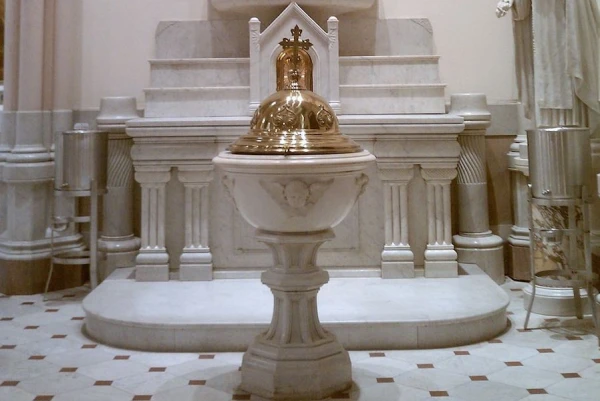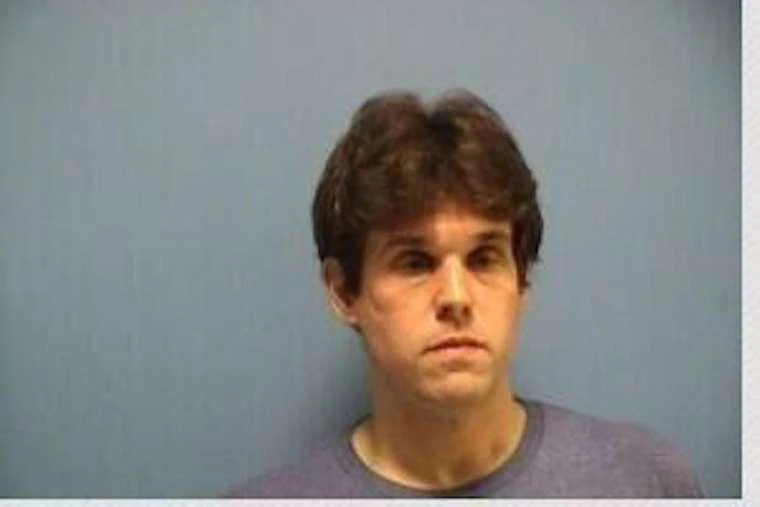
Denver Newsroom, Aug 27, 2020 / 10:00 am (CNA).-
Two parish administrators at two different Philadelphia churches must work to undo church renovations that drew both objections from parishioners and corrections from church officials, who said the priests did not follow archdiocese guidelines.
The archdiocese took “immediate action” after learning about the two different unauthorized renovations at Saint Michael Parish and Saint Borromeo Church in south Philadelphia, Kenneth A. Gavin, chief communications officer at the Philadelphia archdiocese, told CNA last week.
“After learning of concerns reported to the archdiocese by parishioners at both parishes, Archbishop Nelson J. Pérez delegated a liturgical expert to visit each church and report back to him on what the renovations entailed,” Gavin said.
“After receiving a report from that delegate in late July, Reverend Arturo Chagala, parochial administrator of Saint Michael Parish, and Reverend Esteban N. Granyak, parochial administrator of Saint Charles Borromeo Church, were instructed to restore the sanctuaries of the respective church to their former states to greatest extent possible and to address this matter with parishioners publicly.”
Both Archbishop Nelson Perez of Philadelphia and senior leaders in the archdiocese met personally with Saint Charles Borromeo parishioners “to hear and address their concerns.”
“The archbishop and the Archdiocese of Philadelphia will always seriously listen to concerns voiced by parishioners and work to find resolutions that are fair and equitable to all,” Gavin said.
Father Arturo Chagala, the pastoral administrator of Saint Michael’s Parish, has been at the north Philadelphia church since 2014.
Between March and early June, while the church was closed due to the new coronavirus epidemic, he directed that significant renovations take place. Many historic pews were removed, the marble altar rails were taken out, and the church’s hardwood floor and marble center-aisle floor were covered with bright red carpet, the Philadelphia Inquirer reports.
Several parishioners objected to the changes at the church, a designated historic landmark in Philadelphia whose exterior cannot be changed.
Other critics include architectural historian Oscar Beisert.
“He took a classically beautiful building and vandalized it,” Beisert told the Inquirer. “I call it architectural vandalism.”
Chagala has promised to finish restoration work by Sept. 11.
“As you might imagine, it is rather humbling for me to bring all this to your attention. I apologize for all the upset,” the priest said in a June 20 letter to parishioners.
He said Archbishop Nelson Perez met with him on June 18 to discuss parishioners’ upset reaction to the renovations.
“The archbishop was frank and clear about his deep concern with regard to these renovations and directed a pathway to move forward,” the priest said. The renovations took place “without the proper permission and oversight” from the archdiocese. There was no “broad consultation with parishioners,” Chagala acknowledged.
The protocols of the archdiocese’s Office for Divine Worship require plans to be submitted for review and approval by the archbishop before any work begins, and the archdiocesan moderator of the curia reviews the project for financial feasibility.
Chagala said the renovations have divided the parish and there is a need “to focus on greater transparency and communication among us.”
He praised the legacy of the parish and its current parishioners.
“I have a pastoral duty to reach out to all of you and support you in your life of faith,” he said. “In order for me to do this more effectively, I pledge to take the needed steps to bridge the divide that now marks us, and with your support, to build up the parish of St. Michael’s,” he said.
Another renovation controversy took place at St. Charles Borromeo Church in south Philadelphia, where parish administrator Father Esteban Granyak this summer removed the marble altar rail, moved the main altar, renovated a chapel and converted a basement gym into a worship space for members of the Neocatechumenal Way, a Catholic movement of spiritual formation and evangelization.
The changes were made without consulting parishioners at the 152-year-old historically African-American parish.
In addition to objecting to the lack of consultation, some Black parishioners objected that the parish has stopped using a cross long used by the community during Mass.
Parishioners also said Black parishioners traditionally used the basement gym for social gatherings or for receptions after funerals, and that the parish does not pay enough attention to Black parishioners, or the social issues relevant to them, such as the death of George Floyd while being detained by police in Minneapolis, Minn.
Some parishioners accused Granyak, the parish administrator, of engaging in insensitive and racist practices and of giving preferential treatment to the Neocatechumenal Way.
“We are being tossed aside. We have no connection to what is going on at St. Charles Parish at all,” 76-year-old Carolyn Jenkins, a lifelong parishioner and member of the parish council, told the Inquirer in July.
Jenkins and others have protested outside the parish church. She said they wanted the priest removed.
“There’s no way he can stay here with all the bad history and signs of racism we have experienced,” she said.
Gavin responded to some of the claims against Granyak.
“Allegations of racism are not taken lightly by the archdiocese,” he told the Inquirer in July. “Racial hatred has no place in our Church or in the hearts of people. Racism is a mortal sin and an attack on the gift of life. No complaints of racially motivated behavior have been lodged against Father Granyak with the archdiocese.”
He noted that parish communities include people from various age groups and cultural and ethnic backgrounds.
“In addition to the African-American community within the parish, it is important to note that Father Granyak is Chilean and that many parishioners hail from Latin America with a mixture of families from Spain and Italy,” he said.
Gavin said that the priest had announced that space for gatherings is available to parishioners, although Jenkins said she has not heard such announcements. Parishioners also questioned Gavin’s report that they did not return calls to the priest when he was trying to meet with parishioners before a July 5 protest.
Both Granyak and Chagala are part of the Neocatechumenal Way.
The Neocatechumenal Way, founded in 1964, forms small parish-based communities for formation in the Christian life, and focuses on door-to-door and other direct forms of evangelization, personal conversion, and the universal call to holiness.
While the Way is often lauded for its successes in Christian evangelization, and its large number of priestly vocations, critics point to its unusual liturgical style and have accused it of forming parallel communities in the parishes where it operates. More than one million people around the world are associated with the Neocatechumenal Way.
When the Neocatechumenal Way is present in a diocese, it is often responsible for bringing numerous priestly vocations from around the world, though some critics say those priests do not always integrate well into the local communities they serve.
While local news reports have cited critics of the local movement and described rifts between it and longtime parishioners, Gavin told the Inquirer in August that it is “baseless” to depict the movement as “taking over a parish.”
“The Catholic Church embraces and celebrates diversity while maintaining focus on what unites us as a family of hope and faith — the Resurrection of Jesus Christ,” he said, adding that parishioners who are not members are welcome at its Saturday evening liturgies.
“The Neocatechumenal Way is a distinct charism within the Roman Catholic Church that is sanctioned by the Vatican,” he continued. “Its liturgical celebrations have some elements that are different from what parishioners would traditionally experience.
If you value the news and views Catholic World Report provides, please consider donating to support our efforts. Your contribution will help us continue to make CWR available to all readers worldwide for free, without a subscription. Thank you for your generosity!
Click here for more information on donating to CWR. Click here to sign up for our newsletter.




In the article, Father Arturo Chagala, the pastoral administrator of Saint Michael’s Parish, and St. Charles Borromeo Church parish administrator Father Esteban Granyak are blamed for the changes. What were the pastors doing? Or, are those positions vacant?
Those places do not have pastors. A Parochial Administrator is equivalent in law to a pastor (although there are some technical differences). Usually a priest is the administrator of a parish when he is newly assigned. That position (depending upon the diocese) may last for numerous months while the priest decides if he wants to be the pastor. The priest usually writes a letter to his bishop requesting he be made pastor.
Yes but an Administrator has restrictions a pastor does not have according to Canon Law. One is that they not make drastic changes because the position is usually short term.
Why would these priests think they have authority to do these things?
Who paid for the wreckovations and who is now paying for the restorations? Money wasted!
I think the main issue here is the fact that both Administrators in this story took advantage of the COVID shut-down to alter the traditional architectural elements still surviving in their churches. One can only suppose that they did so under these circumstances because they knew that those actions would be met with resistance from their parishioners, and they would prefer to present them as a “fait accompli” to be accepted rather than as a proposal which might be rejected.
And such a proposal should be rejected, as was the “fait accompli.” Nothing in any ecclesiastical document and nothing from tradition suggests in the least the removal of the demarcation between sanctuary and nave–an architectural feature ubiquitous in churches of every rite for as far back in history as we can look. Even the first-century ruins of the domus ecclesia of Peter in Capernaum, excavated in the 1960’s, reveals evidence of such a demarcation. Whether it is a rood screen, an iconostasis, heavy curtains, or an altar rail, such a feature is a mark of the Apostolic Faith with its belief in a sacrificial priesthood united to Jesus Christ, in whom the boundary between heaven and earth, though impermeable by merely human effort, is transcended by the power and initiative of God.
The compulsion to excise this feature from liturgical architecture has been a scourge on Catholic worship since the 1960’s, and it is harmful to the faith, as evinced in the fact than only a little more than 30% of Catholics today accept the dogma of the True Presence of Christ in the Eucharist.
I applaud the archbishop for correcting this offense.
Our ecclesial culture is dominated by Catholics throughout the Church’s structure who are convinced it is their mission to convert the rest of the Church to their vision. What is received is never good enough for the long march to the mythical “land of forward.”